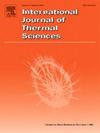A new hybrid CFD approach to study the impact of forced convection on radiant cooled wall with baseboard diffuser including various vane angles
IF 4.9
2区 工程技术
Q1 ENGINEERING, MECHANICAL
International Journal of Thermal Sciences
Pub Date : 2025-02-24
DOI:10.1016/j.ijthermalsci.2025.109804
引用次数: 0
Abstract
The current work examines the effect of forced convection on thermal comfort in a space, including radiant wall cooling and an innovative floor-level diffuser system. It examines the impact of various vane angles on thermal comfort in room air conditioning at 15°, 30°, 45°, 60°, and 75°, and employs experimental data to confirm a hybrid 3D computational fluid dynamics (CFD) model. A new floor-level diffuser system delivers air at temperatures between 18 °C and 22 °C, with supply air velocities of 5 m/s and 10 m/s measured at the exit side of diffuser while the supply water temperature is kept constant at 14 °C. In the hybrid 3D solution, experimentally derived convective heat transfer coefficients (CHTCs) for forced airflow are utilized. This is accomplished by merging a k-ω model with a hydronic radiant panel system that incorporates forced convection. The analysis examines temperature and velocity distributions, CHTCs on the radiant-cooled wall, and the PMV-PPD components. Results indicate that at a supply air velocity of 5 m/s, thermal comfort parameters do not satisfy PMV and PPD indices, except in proximity to the diffuser. Nevertheless, elevating the supply air velocity to 10 m/s ensures thermal comfort across the space, with the exception of regions next to the cooled wall surfaces. The examination of several vane angles indicated that a 45° angle yields the most advantageous thermal comfort conditions, irrespective of air velocity. The CHTC adjacent to the radiant wall is roughly 6 W/m2K at a velocity of 5 m/s and rises to 8 W/m2K at 10 m/s. The temperature disparity between the head and ankle regions at 5 m/s adheres to the 3 °C tolerance established by international standards. The study determines that a 45° vane angle ensures best thermal comfort, and the devised numerical method yields significant insights for the construction of analogous indoor settings.
求助全文
约1分钟内获得全文
求助全文
来源期刊

International Journal of Thermal Sciences
工程技术-工程:机械
CiteScore
8.10
自引率
11.10%
发文量
531
审稿时长
55 days
期刊介绍:
The International Journal of Thermal Sciences is a journal devoted to the publication of fundamental studies on the physics of transfer processes in general, with an emphasis on thermal aspects and also applied research on various processes, energy systems and the environment. Articles are published in English and French, and are subject to peer review.
The fundamental subjects considered within the scope of the journal are:
* Heat and relevant mass transfer at all scales (nano, micro and macro) and in all types of material (heterogeneous, composites, biological,...) and fluid flow
* Forced, natural or mixed convection in reactive or non-reactive media
* Single or multi–phase fluid flow with or without phase change
* Near–and far–field radiative heat transfer
* Combined modes of heat transfer in complex systems (for example, plasmas, biological, geological,...)
* Multiscale modelling
The applied research topics include:
* Heat exchangers, heat pipes, cooling processes
* Transport phenomena taking place in industrial processes (chemical, food and agricultural, metallurgical, space and aeronautical, automobile industries)
* Nano–and micro–technology for energy, space, biosystems and devices
* Heat transport analysis in advanced systems
* Impact of energy–related processes on environment, and emerging energy systems
The study of thermophysical properties of materials and fluids, thermal measurement techniques, inverse methods, and the developments of experimental methods are within the scope of the International Journal of Thermal Sciences which also covers the modelling, and numerical methods applied to thermal transfer.
 求助内容:
求助内容: 应助结果提醒方式:
应助结果提醒方式:


